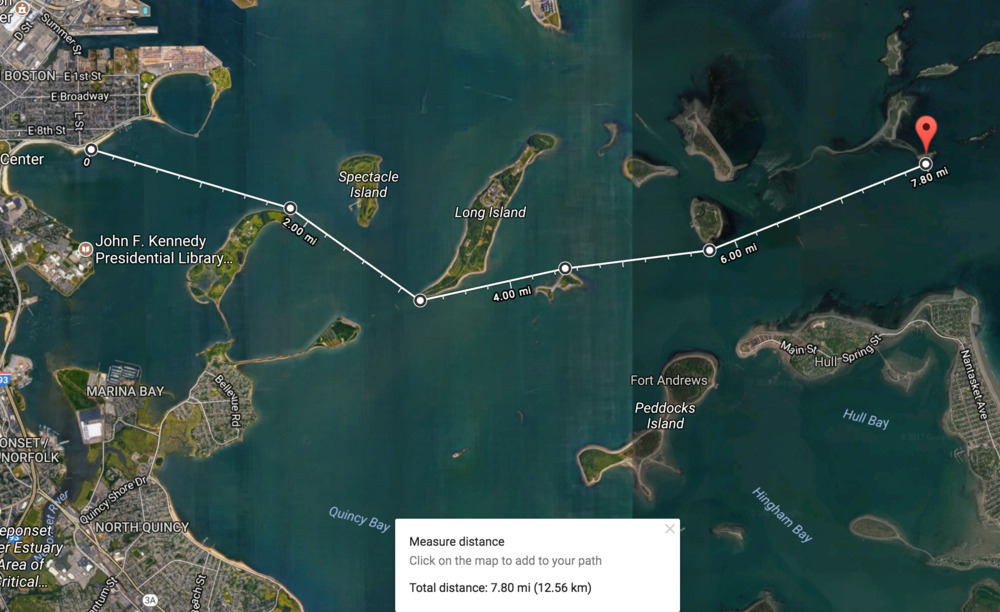Natural Routes vs. Artificial Routes
An open water swim route consists of:
- a start location
- a finish location
- possibly, one or more intermediate waypoints (if the route is not a straight line).
Routes matter in open water swimming, because they determine the official distance of a swim (not the GPS track).
In this article I discuss the distinction between natural routes (defined by permanent land features) and artificial routes (such as buoy courses), and the implications for categorizing marathon swims and distance records.
Natural Routes
A natural route is defined by the natural geography of a body of water. The start, finish, and intermediate waypoints correspond to permanent physical land features that enforce a minimum route distance.
Many well-known marathon swims are natural routes:
- A swim across the English Channel is defined by a start (England), a finish (France), and the 20.5-mile wide body of water (at its narrowest) that enforces the route distance.
- A swim around Manhattan Island starts and finishes at the same location, and the minimum route distance of 28.5 miles is enforced by the circumference of the island itself.
- The Boston Light Swim starts at Little Brewster Island and finishes at the L Street Bathhouse. The minimum 7.8-mile route is enforced by natural features of Boston Harbor (Georges Island, Rainsford Island, Long Island, and Thompson Island).
 Boston Light Swim route.
Boston Light Swim route.
Because they are defined and enforced by permanent land features, natural routes are repeatable - across different days, different years, and different swimmers.
(Note: certain “artificial” features, such as bridges, which remain in the same place over many years, are effectively permanent and can also qualify for natural routes. Examples: the swim from the Farallon Islands to the Golden Gate Bridge; or the seven stages of the 8 Bridges Hudson River Swim.)
Artificial Routes
An artificial route has at least one impermanent or portable course marker (such as a buoy) to enforce the swim distance. Buoy routes are commonly used in mass-participation races, and can offer increased flexibility and simplified logistics for race organizers. Buoys allow routes of virtually any distance to be set up in virtually any body of water.
 2012 Olympic 10km course in London’s Serpentine.
2012 Olympic 10km course in London’s Serpentine.
One consequence of the impermanence of buoy routes is they typically are not repeatable. Buoys can move, so the route may vary from day to day and year to year. If the route potentially changes over time, it’s difficult to compare different swims on different days. Thus “course records” are not typically meaningful on artificial routes. Even if great care is taken to set the buoys at specific GPS coordinates, they are still subject to wind drift, GPS inaccuracy, and course cutting.
Why does this matter?
Repeatability of Solo Swims
In a race, you compete against other swimmers on the same day, on the same course. Route repeatability across different days and years is less important for races.
But a solo swim is considered alongside all others who have completed the same swim - on different days and in different years. In this case, route repeatability matters. Conditions, water temperature, GPS tracks, and other open water variables may differ, but when you swim from England to France, you know you achieved the same feat as Captain Webb in 1875. You entered the water from one land, and swam to another land. Route repeatability allows this comparison.
If you are establishing a new swim route, consider that future swimmers may want to replicate your swim. Look to the permanent, natural geography of the water in planning your route.
Aesthetics
Beyond the repeatability issue, many open water swimmers find natural routes more interesting and aesthetically pleasing than artificial routes. Consider the enduring popularity of buoy-less swims like the Horsetooth 10K, the Swim Around Key West, the Tampa Bay Marathon Swim, and Swim the Suck. These events have a strong sense of place and harmony with the surrounding environment, providing swimmers with a fulfilling feeling of “going somewhere” that buoy courses lack.
Not every body of water can support a natural route, especially if there are specific distance parameters, such as 10K or 2.4 miles. Safety considerations may also require containing swimmers inside a buoy course. But if a natural route is feasible, race organizers should strongly consider it.
Distance Records
The longest solo marathon swims on record (unassisted by nonstandard equipment, and unaided by surface currents) are:
- Sarah Thomas’ 80-mile (128.7 km) swim in Lake Powell - a natural route between Bullfrog, Utah and Wahweap, Arizona, enforced by the geography of the lake.
- Chloe McCardel’s 77.3-mile (124.4 km) ocean swim across the Exuma Sound - a natural route from South Eleuthera Island to Nassau city.
One might ask: If you swam 81 laps – or even 100 laps – around a 1-mile buoy course, would that surpass a 77-mile point-to-point ocean swim, or an 80-mile point-to-point lake swim? Could a 100-mile swim on an artificial buoy course set a marathon swimming distance record?
In my opinion, no. The gold standard in marathon swimming is the point-to-point route enforced by natural geography - swims like Sarah’s and Chloe’s. Any challenges to these records should respect the same standard. A buoy route or other unenforced route would not be a legitimate challenger.
This article benefited from discussions with David Barra.
Other articles on marathon swimming routes: